
随着工业运营与数字系统的融合,OT与IT边界逐渐模糊,带来了新的网络安全挑战。统一的安全架构通过实时可见性、自动化威胁检测与协调响应,消除了传统安全工具的碎片化问题。Seceon的平台实现了跨环境的全面保护与高效管理。 2025-10-29 09:43:1 Author: securityboulevard.com(查看原文) 阅读量:6 收藏
As industrial operations and digital systems continue to merge, organizations are entering a new era of cybersecurity challenges. The boundaries between Operational Technology (OT) and Information Technology (IT) have blurred, and with this convergence come both opportunities and risks.
Traditionally, OT and IT have operated in silos. OT systems controlled machinery, sensors, and industrial processes, while IT managed data, users, and applications. Each was secured separately, often with different tools, teams, and standards. But attackers no longer respect those boundaries. A breach in one domain can easily spill into the other.
It’s time for a change, and that change begins with Converged OT/IT Cybersecurity, a unified security architecture that brings visibility, intelligence, and response together under one platform. Seceon’s platform is purpose-built for this convergence, unifying OT and IT security with real-time visibility, automated threat detection, and orchestrated response across every layer of the enterprise.
Understanding the Converged Architecture
At the heart of convergence lies the Unified Security Platform, which bridges the gap between industrial and digital systems to deliver comprehensive protection.
Let’s look at how both sides come together:
Operational Technology (OT)
- Level 0-1: Process Control — PLCs, DCSs, sensors, actuators
- Level 2: Supervisory — SCADA systems, HMI interfaces, data servers
- Level 3: Manufacturing — MES, production systems, control networks
- Protocols — Modbus, DNP3, DeviceNet, Profinet
Information Technology (IT)
- Level 4-5: Enterprise — corporate applications, databases, user endpoints, and cloud services
- Cloud and SaaS — platforms that extend IT reach into connected environments
- Endpoints — desktops, servers, mobile devices
- Protocols — TCP/IP, HTTPS, SMTP, LDAP
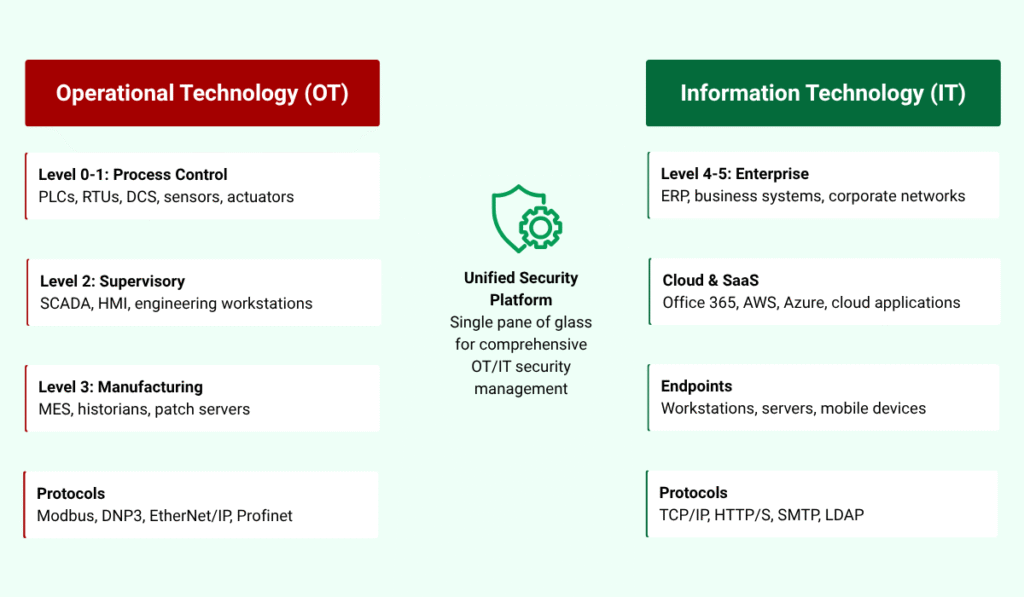
When these layers operate independently, blind spots appear between them. A unified security platform eliminates those gaps, ensuring every device, process, and data flow is visible and protected across both environments. This is exactly where Seceon’s strength lies, providing a single security fabric that seamlessly bridges industrial and enterprise systems, simplifying management while improving protection.
The Power of Unified Security Controls
Convergence doesn’t just connect systems; it harmonizes how they are protected.
A modern converged architecture delivers six key capabilities:
1. Unified Asset Discovery
Provides comprehensive visibility of every connected asset across IT and OT environments. It supports continuous updates, asset classification, and contextual security mapping.
2. Cross-Domain Analytics
Brings together behavioral and contextual intelligence from both domains. Using AI, it detects anomalies that span across networks, users, and machines.
3. Unified Threat Detection
Correlates multi-layer telemetry to identify threats early. AI models analyze normal behavior and detect deviations instantly.
4. Orchestrated Response
Automates containment and recovery actions across IT and OT, ensuring incidents are handled consistently and swiftly.
5. Converged Identity Management
Centralizes authentication and access control. Every user and device interaction is monitored and managed across systems.
6. Unified Compliance
Simplifies adherence to security frameworks like ISO, NIST, and NIS2 by automating data collection, audit trails, and reporting.
Together, these capabilities transform how organizations detect and respond to threats, moving from fragmented tools to a cohesive, intelligent defense. Seceon delivers this cohesive defense through its unified aiSIEM and aiXDR platform, combining asset discovery, AI-driven analytics, threat correlation, and automated remediation into one continuous process.
How Convergence Improves Capabilities
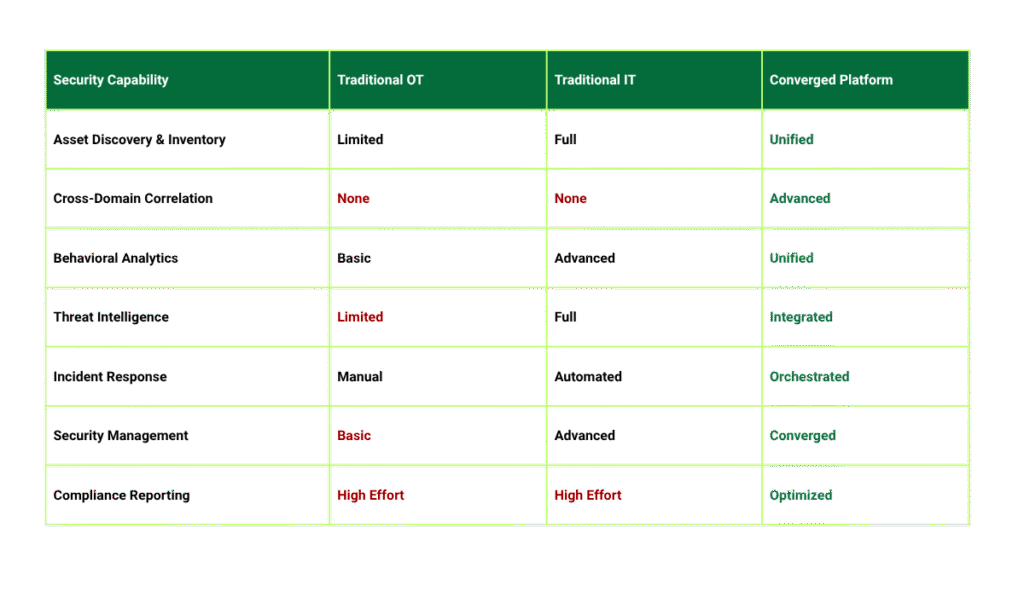
Convergence replaces complexity with clarity and coordination. It unifies tools, data, and teams under one framework that sees everything and responds faster.
Quantified Value of Convergence
Organizations that have implemented a unified OT/IT architecture report impressive outcomes:
- 75% reduction in tool complexity
- 90% faster cross-domain threat detection
- 60% lower total cost of ownership
- 85% faster incident response time
- 95% compliance automation coverage
- 80% reduction in security silos
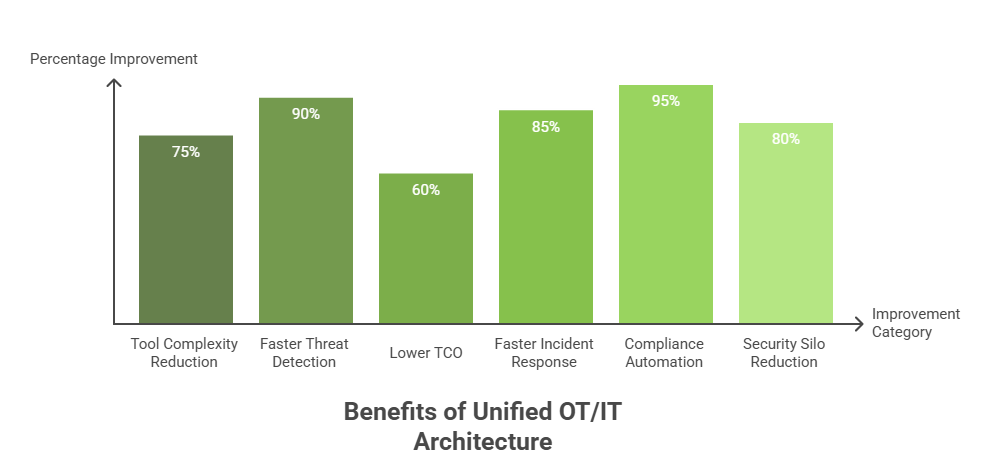
These are not just numbers; they represent real-world operational resilience and efficiency.
Seceon’s customers have seen similar results, achieving faster detection, reduced complexity, and improved compliance through the company’s AI-powered threat management approach.
The Convergence Roadmap
Transitioning to a converged security model follows four clear stages:
1. Assessment and Planning
Begin with a full evaluation of your current environment. Identify security gaps and define a roadmap for integration.
2. Foundation Deployment
Deploy the unified security platform, establish cross-domain connectivity, and ensure data flows securely between IT and OT systems.
3. Advanced Analytics Integration
Enable AI-driven analytics and correlation engines to uncover hidden threats and automate risk insights.
4. Orchestrated Response and Optimization
Implement automated playbooks, continuous monitoring, and continuous improvement to maintain agility and protection over time.
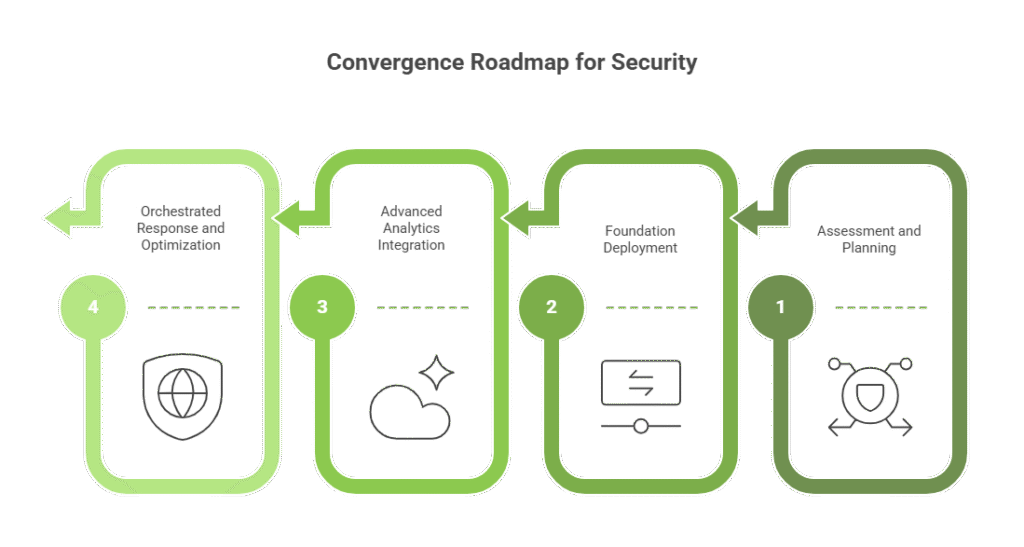
Seceon’s modular platform aligns perfectly with this roadmap. Organizations can start with foundational visibility and analytics, then expand to full automation and orchestration as maturity grows.
Why Convergence Matters
Breaking down silos isn’t just about technology; it’s about achieving unified protection, streamlined processes, and smarter decision-making.
Convergence enables:
- Unified visibility across all systems and assets
- Accelerated threat detection with AI-driven analysis
- Cost optimization through reduced overlap and fewer tools
- Enhanced protection with coordinated defense mechanisms
- Streamlined compliance with automated frameworks
- Strategic alignment between IT, OT, and business goals
When IT and OT operate as one, security becomes proactive rather than reactive.
Inside the Converged Platform
A unified security platform is built around key technical pillars that make convergence effective:
Unified Data Lake
Collects and normalizes data from all systems for real-time analytics, correlation, and historical insight.
Protocol Bridge
Brings together industrial and IT protocols to ensure both environments speak the same security language.
Converged AI Engine
Applies machine learning to detect, predict, and adapt to emerging threats.
Orchestration Engine
Automates workflows, investigations, and response actions to accelerate incident resolution.
Unified Communications
Integrates reporting, collaboration, and notification systems for coordinated response.
Executive Dashboard
Delivers a single view of risk, compliance, and performance for faster strategic decision-making.
Each of these components is part of Seceon’s unified threat management architecture, designed to break data silos, centralize intelligence, and deliver actionable insights for both IT and OT teams.
Investment Impact
The business case for convergence is compelling.
Here’s how organizations benefit compared to maintaining separate OT and IT security stacks:
- 40–55% savings on tool licensing
- 45–55% reduction in security personnel requirements
- 80–85% lower integration and maintenance costs
- 70–75% savings in training and certification expenses
- 75–85% faster recovery during incidents
- 75–80% reduction in compliance audit costs
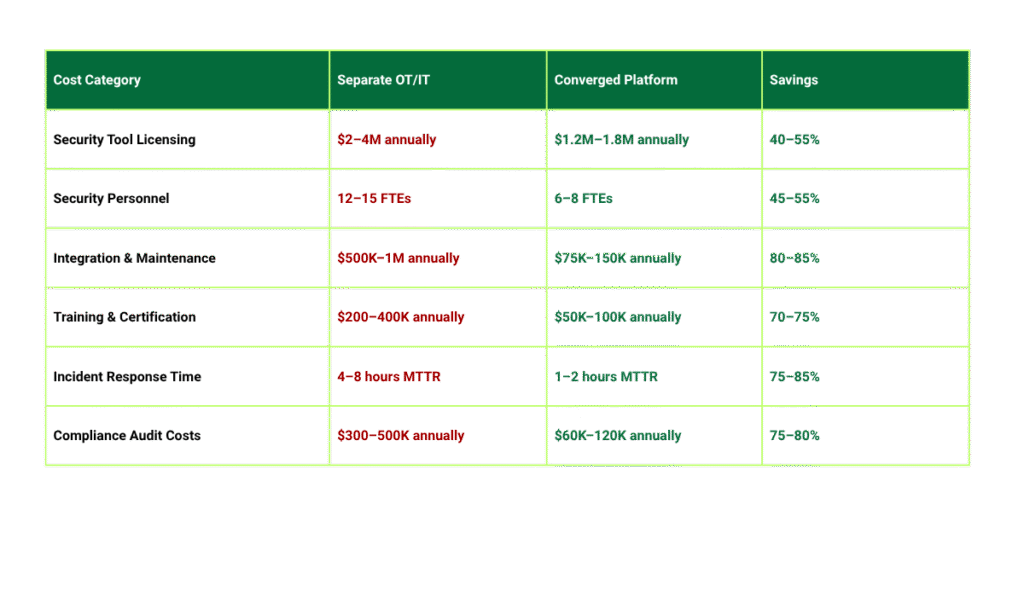
A unified architecture reduces costs while enhancing efficiency and resilience, providing a genuine operational advantage.
With Seceon, organizations not only achieve measurable savings but also strengthen their security posture through automation and predictive analytics that scale effortlessly across environments.
Proven Performance Indicators
Convergence delivers measurable improvements across all critical security metrics:
- Mean Time to Detect (MTTD) under 1 hour
- Mean Time to Respond (MTTR) under 2 hours
- 99.9% system availability
- False positive rate below 0.5%
- 100% compliance coverage
- Continuous 24/7 monitoring
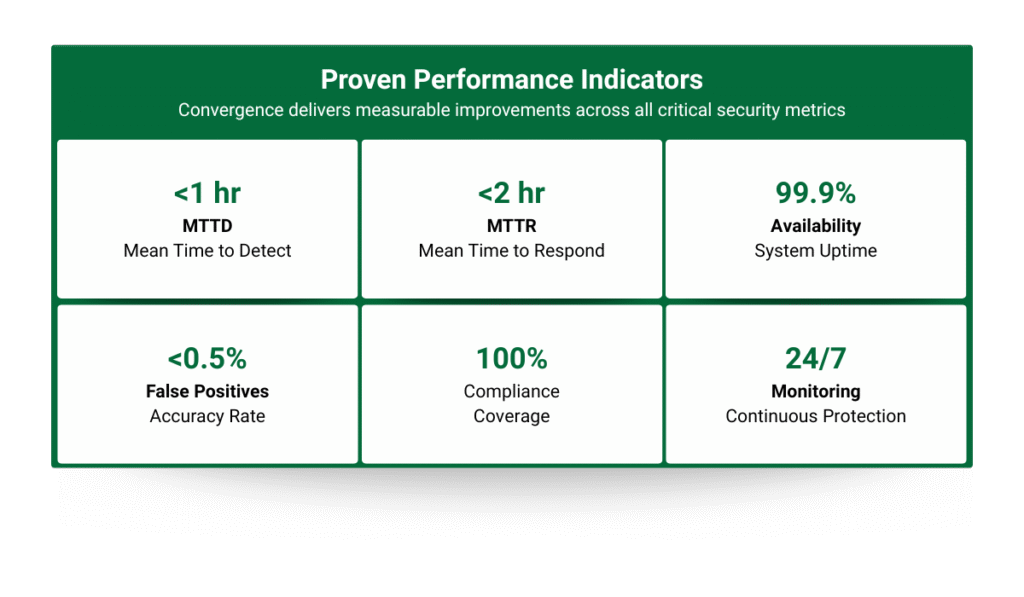
These results demonstrate how unified security translates to both stronger protection and smoother operations.
By converging OT and IT security through Seceon’s unified platform, enterprises gain continuous protection, actionable intelligence, and full visibility into compliance, all in one solution.
Ready for Convergence
Security silos are a thing of the past. The future is unified.
A converged OT/IT security architecture ensures consistent visibility, faster detection, and automated response across every connected system.
Organizations that embrace convergence not only reduce risk but also gain agility, compliance confidence, and long-term cost efficiency.
It’s time to move toward a single, intelligent framework that not only protects your operations and business but also helps you stay one step ahead of evolving threats.

The post Converged OT/IT Cybersecurity: Breaking Barriers for Unified Protection appeared first on Seceon Inc.
*** This is a Security Bloggers Network syndicated blog from Seceon Inc authored by Kriti Tripathi. Read the original post at: https://seceon.com/converged-ot-it-cybersecurity-breaking-barriers-for-unified-protection/
如有侵权请联系:admin#unsafe.sh
